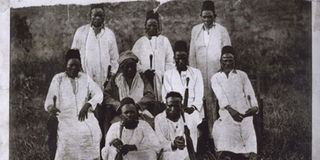Koitalel found a permanent home

Photo/FILE/NATION
The Koitalel Samoei clan.
A visit to Nandi Hills Town is incomplete without a tour of the Koitalel Samoei Museum.
Inside the less than one-acre plot are two buildings; a refurbished colonial house with red tiles that serves as the museum and, next to it, a mausoleum with the statue of Koitalel Samoei, the legendary Nandi leader.
Next to the mausoleum are two traditional grass thatched huts, complete with Kalenjin regalia and cultural artifacts.
Standing tall in the compound are two huge fig trees, one of which is believed to have grown on Samoei’s grave.
“A committee comprising former descendants of Koitalel Samoei has been constituted to coordinate activities at the museum including annual commemoration ceremonies,” said Fredrick Kipchirchir Talam, the curator.
The committee of 60 elders is currently headed by George Samoei and Stephen Sugut and is responsible for organising the annual commemoration ceremony held on 19th of October to coincide with the time Samoei was killed more than a century ago.
In one corner of the four-roomed museum are Samoei’s royal batons inside a glass case.
“These treasured staffs of office of Orgoiyot Koitalel Samoei were recovered through the diligent efforts and guidance of Egyptologist Dr Kipkoech arap Sambu and doctoral student Kipnyango arap Seroney with cooperation of Col Richard Meinertzhagen, son of Randle Meinertzhagen, on 23rd of January 2006,” states a notice on the case.
Koitalel Samoei was shot dead in October 1905 at Ketbarak, near what is now the Nandi Bears Club.
The shield shaped mausoleum signifying the traditional bullet proof guard used by warriors during the Nandi resistance cost Sh20 million, given by the Government when President Kibaki visited the site in 2005.
The outer wall of the mausoleum is of hard stones which will be painted white in deference to the name Koitalel, meaning white stone.
The mausoleum has two doors with the main entrance facing Mt. Elgon, believed to be the entry point of the Kalejin during their migration.
The rear door, which faces south, is lower and can be entered only by crouching and is used mainly for ceremonies, especially during boys’ initiations.
On the eastern side is Samoei’s symbolic grave, designed in marble to demonstrate that the hero’s head is missing.
The colonialists chopped off Samoei’s head after shooting him and took it together with other regalia to the UK. The skull is believed to be in the Pitt Rivers Museum, in Oxford.
Available documentation indicates more than 1,000 Kenyan artifacts are in the British Museum and Pitt Rivers.
The inner roof of the mausoleum is supported by four pillars, like the Kalenjin elders’ stool. It signifies stability and unity among the community.
The mausoleum will also have a statue of Koitalel Samoei with the symbol of a lion associated with his Talai clan.
Sandwiched between the pillars will be the Koitalel traditional pot that contained the brew used during the foretelling of the coming of colonialists.
It will also have a metal snake indicating the railway line that Koitalel predicted and fought so hard to prevent. One of the key objectives of the museum is to preserve the Nandi culture.

